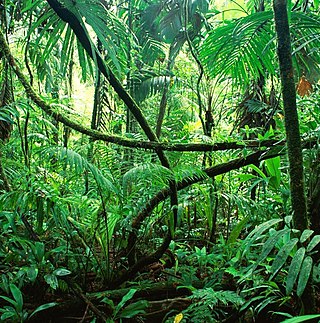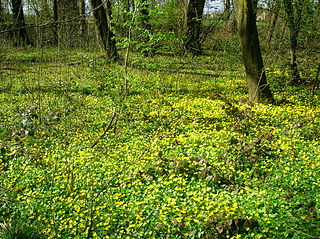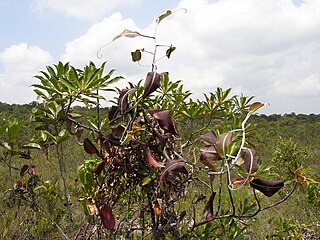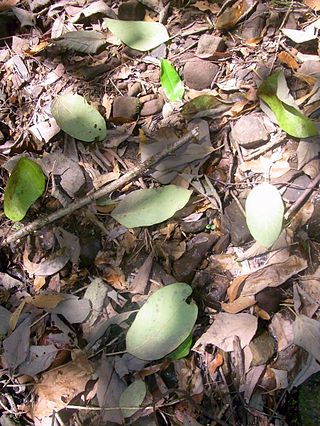
Rainforests are forests characterized by a closed and continuous tree canopy, moisture-dependent vegetation, the presence of epiphytes and lianas and the absence of wildfire. Rainforests can be generally classified as tropical rainforests or temperate rainforests, but other types have been described.

A mycorrhiza is a symbiotic association between a fungus and a plant. The term mycorrhiza refers to the role of the fungus in the plant's rhizosphere, its root system. Mycorrhizae play important roles in plant nutrition, soil biology, and soil chemistry.

In forestry and ecology, understory, or understorey, also known as underbrush or undergrowth, includes plant life growing beneath the forest canopy without penetrating it to any great extent, but above the forest floor. Only a small percentage of light penetrates the canopy so understory vegetation is generally shade-tolerant. The understory typically consists of trees stunted through lack of light, other small trees with low light requirements, saplings, shrubs, vines and undergrowth. Small trees such as holly and dogwood are understory specialists.

Tropical rainforests are rainforests that occur in areas of tropical rainforest climate in which there is no dry season – all months have an average precipitation of at least 60 mm – and may also be referred to as lowland equatorial evergreen rainforest. True rainforests are typically found between 10 degrees north and south of the equator ; they are a sub-set of the tropical forest biome that occurs roughly within the 28-degree latitudes. Within the World Wildlife Fund's biome classification, tropical rainforests are a type of tropical moist broadleaf forest that also includes the more extensive seasonal tropical forests.

The Sundaland heath forests, also known as Kerangas forest, is a type of tropical moist forest found on the island of Borneo, which is divided between Brunei, Indonesia, and Malaysia, as well as on the Indonesian islands of Belitung and Bangka, which lie to the west of Borneo.

In hydrology, stemflow is the flow of intercepted water down the trunk or stem of a plant. Stemflow, along with throughfall, is responsible for the transferral of precipitation and nutrients from the canopy to the soil. In tropical rainforests, where this kind of flow can be substantial, erosion gullies can form at the base of the trunk. However, in more temperate climates stemflow levels are low and have little erosional power.

Rhizopogon is a genus of ectomycorrhizal basidiomycetes in the family Rhizopogonaceae. Species form hypogeous sporocarps commonly referred to as "false truffles". The general morphological characters of Rhizopogon sporocarps are a simplex or duplex peridium surrounding a loculate gleba that lacks a columnella. Basidiospores are produced upon basidia that are borne within the fungal hymenium that coats the interior surface of gleba locules. The peridium is often adorned with thick mycelial cords, also known as rhizomorphs, that attach the sporocarp to the surrounding substrate. The scientific name Rhizopogon is Greek for 'root' (Rhiz-) 'beard' (-pogon) and this name was given in reference to the rhizomorphs found on sporocarps of many species.

Forest dieback is a condition in trees or woody plants in which peripheral parts are killed, either by pathogens, parasites or conditions like acid rain, drought, and more. These episodes can have disastrous consequences such as reduced resiliency of the ecosystem, disappearing important symbiotic relationships and thresholds. Some tipping points for major climate change forecast in the next century are directly related to forest diebacks.

Dicymbe is a genus of 20 species of canopy trees in the family Fabaceae, within subfamily Detarioideae. It is found throughout the Guyana Shield region and parts of W Amazonia. Certain species within the genus are strongly associated with ectomycorrhizal fungi.

Plant litter is dead plant material that have fallen to the ground. This detritus or dead organic material and its constituent nutrients are added to the top layer of soil, commonly known as the litter layer or O horizon. Litter is an important factor in ecosystem dynamics, as it is indicative of ecological productivity and may be useful in predicting regional nutrient cycling and soil fertility.

A mycorrhizal network is an underground network found in forests and other plant communities, created by the hyphae of mycorrhizal fungi joining with plant roots. This network connects individual plants together. Mycorrhizal relationships are most commonly mutualistic, with both partners benefiting, but can be commensal or parasitic, and a single partnership may change between any of the three types of symbiosis at different times.

Soil carbon storage is an important function of terrestrial ecosystems. Soil contains more carbon than plants and the atmosphere combined. Understanding what maintains the soil carbon pool is important to understand the current distribution of carbon on Earth, and how it will respond to environmental change. While much research has been done on how plants, free-living microbial decomposers, and soil minerals affect this pool of carbon, it is recently coming to light that mycorrhizal fungi—symbiotic fungi that associate with roots of almost all living plants—may play an important role in maintaining this pool as well. Measurements of plant carbon allocation to mycorrhizal fungi have been estimated to be 5 to 20% of total plant carbon uptake, and in some ecosystems the biomass of mycorrhizal fungi can be comparable to the biomass of fine roots. Recent research has shown that mycorrhizal fungi hold 50 to 70 percent of the total carbon stored in leaf litter and soil on forested islands in Sweden. Turnover of mycorrhizal biomass into the soil carbon pool is thought to be rapid and has been shown in some ecosystems to be the dominant pathway by which living carbon enters the soil carbon pool.

An ectomycorrhiza is a form of symbiotic relationship that occurs between a fungal symbiont, or mycobiont, and the roots of various plant species. The mycobiont is often from the phyla Basidiomycota and Ascomycota, and more rarely from the Zygomycota. Ectomycorrhizas form on the roots of around 2% of plant species, usually woody plants, including species from the birch, dipterocarp, myrtle, beech, willow, pine and rose families. Research on ectomycorrhizas is increasingly important in areas such as ecosystem management and restoration, forestry and agriculture.

Ectomycorrhizal extramatrical mycelium is the collection of filamentous fungal hyphae emanating from ectomycorrhizas. It may be composed of fine, hydrophilic hypha which branches frequently to explore and exploit the soil matrix or may aggregate to form rhizomorphs; highly differentiated, hydrophobic, enduring, transport structures.

Cenococcum geophilum Fr., synonym Cenococcum graniforme (Sow.) Ferd. and Winge, is an Ascomycete fungal species and is the only member in the genus Cenococcum. It is one of the most common ectomycorrhizal fungal species encountered in forest ecosystems. The geographic distribution of the species is notably cosmopolitan; it is found in ecosystems with a wide range of environmental conditions, and in many cases in high relative frequency. Because of its wide distribution and abundance in forest soils, it is one of the most well-studied ectomycorrhizal fungal species. While the species has long been known to be sterile and not produce asexual or sexual spores, cryptic sexual stages may exist. The hyphae produced by C. geophilum are characterized by their thick (1.5-8 um), straight and jet black appearance with little branching. They usually form monopodial (unbranched) ectomycorrhizas. The mantles of C. geophilum ectomycorrhizas are usually thick with few to many emanating hyphae.
A canopy root, also known as an arboreal root, is a type of root that grows out of a tree branch underneath an epiphytic mat. These adventitious roots form in response to moist, dark, nutrient-rich conditions that are found in “canopy soils”. Canopy roots have been found in species of maple, poplar, alder, myrtle, beech, and spruce, among many others. They are structurally similar to roots found on the forest floor and likely serve a similar purpose for water and nutrient uptake, though their specific functions are still being studied.

Gilbertiodendron dewevrei is a species of tree in the family Fabaceae, native to tropical rain forests in Central Africa. It is often the dominant tree species of the Guineo-Congolian rainforest. The timber is traded as limbali, and is used for construction, flooring and railway sleepers. It is also used for making boats, furniture, tool handles and joinery and for making charcoal.

The Guineo-Congolian region is a biogeographical region in Africa straddling the Equator and stretching from the Atlantic Ocean through the Congo Basin to the Congo / Nile divide in Rwanda and Burundi. Formerly, this region was largely covered in rain forest, on both well-drained sites and in swamp forests, but little undisturbed primary forest now remains, having been replaced in many areas by savanna and secondary-growth forest.

Rhizopogon salebrosus is a mushroom species within the Rhizopogon sub-genus Amylopogon. R.salebrosus is a monotropoid mycorrhiza that is of vital importance to the ecology of conifer forests, especially in the Pacific Northwest region of North America. Although it is native to North America, R. salebrosus has been found in Europe and its range is generally limited to mountainous regions with sufficient precipitation. The mycoheterotrophic plant, Pterospora andromedea is often found in an obligate association with R. salebrosus in western parts of the U.S. Eastern populations of P. andromedea are typically symbiotic with another Rhizopogon sub species, R. kretzerae.
Anthonotha fragrans is a medium to large sized tree commonly found in the rainforest environments of West and Central Africa; it belongs to the Fabaceae family. Its sapwood exudes a white to creamy exudate.



















